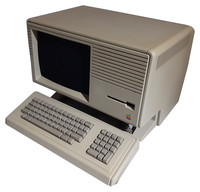Apple Lisa
| Home > Browse Our Collection > Computers > Apple Computers > Apple Lisa |
|
The Apple Lisa was a 16-bit machine, based around the Motorola 68000, which came with a 5Mb Winchester hard disc and 1Mb of RAM. The computer had a built-in monochrome screen and a dual 5.25-inch floppy disk drive. It was released in the US in January 1983, and in the summer of 1983 in the UK. However, the thing that made the Apple Lisa a landmark machine was that it was the first commercially available computer to offer a Graphical User Interface (or GUI). Up until this point all machines had to controlled by typing in commands via the keyboard, but the Lisa was supplied with a mouse and allowed the user to 'point and click' just like operating systems today. The idea of a "point and click" operating system was not invented by Apple. In actual fact it was developed by Xerox at their Palo Alto Research Centre (PARC). They had developed the Alto computer in 1973 which incredibly featured many facilities that we now take for granted on our desktop computers - features like networking, email, object oriented programming and the graphical user interface. However, the Alto was just a research project and was not commercially available and even if it were to be, the cost would have been beyond any reasonable figure. It was only after a visit by the Apple team to PARC that the idea of developing a cost effective computer based around the graphical user interface came to be, resulting in the Apple Lisa. Apparently "Lisa" stands for "Local Integrated Software Architecture", but it is well documented that Steve Jobs, Apple's co-founder, named the machine after his daughter. This Lisa has the XL ROM fitted, which brought it far more in line with the regular Macintosh range. Manufacturer: Apple Comment on This Page Apple Lisa Manuals:
Apple Lisa Articles:
Magazines RELATED to Apple Lisa in our Library
Other Systems Related To Apple Lisa:This exhibit has a reference ID of CH194. Please quote this reference ID in any communication with the Centre for Computing History. |
Click on the Image(s) For Detail
|











